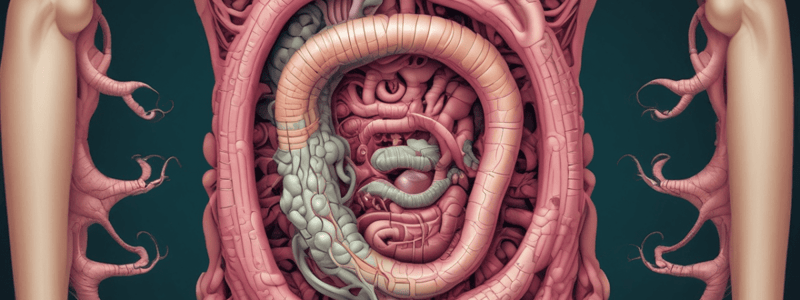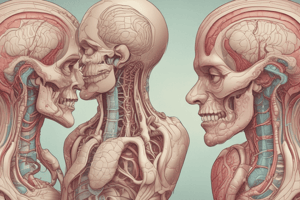Podcast
Questions and Answers
What is the primary cause of diverticulitis?
What is the primary cause of diverticulitis?
- Diet lacking sufficient fiber (correct)
- Inadequate mucus production in the colon
- Diet rich in fiber
- Vigorous peristalsis in the colon
Which of the following is a symptom of appendicitis?
Which of the following is a symptom of appendicitis?
- Frequent diarrhea and weight loss
- Bloating and discomfort in the upper right quadrant
- Referred pain in the umbilical region (correct)
- Severe abdominal pain in the lower left quadrant
What is the result of the external anal sphincter staying voluntarily contracted during the defecation reflex?
What is the result of the external anal sphincter staying voluntarily contracted during the defecation reflex?
- The internal anal sphincter relaxes
- Defecation is postponed (correct)
- The rectum fills with feces
- Defecation occurs
What is the main function of the large intestine?
What is the main function of the large intestine?
Which of the following is NOT a disorder of the digestive system?
Which of the following is NOT a disorder of the digestive system?
What is a possible consequence of poor dental hygiene?
What is a possible consequence of poor dental hygiene?
What is a result of bacteria entering the peritoneal cavity?
What is a result of bacteria entering the peritoneal cavity?
What is a possible cause of watery feces?
What is a possible cause of watery feces?
What is a complication of prolonged starvation due to anorexia nervosa?
What is a complication of prolonged starvation due to anorexia nervosa?
What is a possible consequence of inflammation in the digestive system?
What is a possible consequence of inflammation in the digestive system?
What is the primary function of GLP-1 in relation to glucose metabolism?
What is the primary function of GLP-1 in relation to glucose metabolism?
What is the function of the appendix in the body?
What is the function of the appendix in the body?
What is the term for the condition where the anus is closed except during defecation?
What is the term for the condition where the anus is closed except during defecation?
What is the term for the bands of muscle that run the length of the colon and form haustra?
What is the term for the bands of muscle that run the length of the colon and form haustra?
What is the primary function of the large intestine in relation to the digestion of food?
What is the primary function of the large intestine in relation to the digestion of food?
Where is the liver located?
Where is the liver located?
What is the name of the ligament that connects the liver to the diaphragm and anterior abdominal wall?
What is the name of the ligament that connects the liver to the diaphragm and anterior abdominal wall?
What is the weight of the liver in the human body?
What is the weight of the liver in the human body?
What is the name of the artery that brings oxygenated blood to the liver cells?
What is the name of the artery that brings oxygenated blood to the liver cells?
What is the color of the liver?
What is the color of the liver?
What is the primary mechanism of absorption of short-chain fatty acids in the small intestine?
What is the primary mechanism of absorption of short-chain fatty acids in the small intestine?
Which of the following is NOT involved in the absorption of lipids in the small intestine?
Which of the following is NOT involved in the absorption of lipids in the small intestine?
What is the fate of triglycerides after they enter epithelial cells during lipid absorption?
What is the fate of triglycerides after they enter epithelial cells during lipid absorption?
What is the role of glucagon-like peptide-1 in the small intestine?
What is the role of glucagon-like peptide-1 in the small intestine?
What is the destination of absorbed materials from the small intestine?
What is the destination of absorbed materials from the small intestine?
What is the primary mechanism by which exercise aids in weight loss?
What is the primary mechanism by which exercise aids in weight loss?
What is the primary function of glucagon-like peptide-1 hormones in relation to energy metabolism?
What is the primary function of glucagon-like peptide-1 hormones in relation to energy metabolism?
What is the primary effect of reducing kilocalorie intake on the body's adipose tissue?
What is the primary effect of reducing kilocalorie intake on the body's adipose tissue?
What is the primary mechanism by which semaglutide aids in weight loss?
What is the primary mechanism by which semaglutide aids in weight loss?
What is the primary consequence of consuming excess kilocalories on the body's adipose tissue?
What is the primary consequence of consuming excess kilocalories on the body's adipose tissue?
What is the primary role of glucagon-like peptide-1 receptors in the brain?
What is the primary role of glucagon-like peptide-1 receptors in the brain?
What is the primary effect of inadequate exercise on the body's energy expenditure?
What is the primary effect of inadequate exercise on the body's energy expenditure?
What is the primary consequence of poor diet on the body's energy metabolism?
What is the primary consequence of poor diet on the body's energy metabolism?
What is the primary mechanism by which heredity influences body weight?
What is the primary mechanism by which heredity influences body weight?
What is the primary effect of consuming fewer kilocalories than needed on the body's fat storage?
What is the primary effect of consuming fewer kilocalories than needed on the body's fat storage?
What is the primary function of the folds in the mucosa of the small intestine?
What is the primary function of the folds in the mucosa of the small intestine?
What is the mechanism by which the presence of chyme in the small intestine triggers the secretion of intestinal juice and enzymes?
What is the mechanism by which the presence of chyme in the small intestine triggers the secretion of intestinal juice and enzymes?
What is the primary function of the lacteal in the intestinal villi?
What is the primary function of the lacteal in the intestinal villi?
What is the primary function of the intestinal glands located at the base of the villi?
What is the primary function of the intestinal glands located at the base of the villi?
What is the result of the vigorous segmentation of the small intestine?
What is the result of the vigorous segmentation of the small intestine?
Flashcards are hidden until you start studying
Study Notes
Causes of Obesity
- Heredity, eating habits, inadequate exercise, and poor diet contribute to obesity.
- Excess kilocalories are stored as fats in adipose tissue.
- Consuming fewer kilocalories than needed helps mobilize and break down stored fat.
- Exercise increases energy needs, helping to burn fat more rapidly.
Glucagon-like Peptide-1 (GLP-1)
- Produced by cells of the small intestine.
- Stimulates insulin secretion and inhibits glucagon secretion.
- Slows gastric emptying and reduces food intake.
- Receptors are expressed in many brain regions.
- Semaglutide is a GLP-1 receptor agonist.
Inflammatory Disorders
- Periodontal disease: inflammation, bleeding gingivae, and degeneration of gingivae, cement, periodontal ligaments, and dental alveoli.
- Peritonitis: acute inflammation of peritoneum due to bacterial contamination.
Noninflammatory Disorders
- Constipation: difficult defecation due to hard, dry feces.
- Diarrhea: production of watery feces due to rapid peristalsis in the colon.
- Eating disorders: obsessive concern about weight control, including anorexia nervosa and bulimia.
Obesity
- Results from consuming more kilocalories than needed to meet energy needs.
- GLP-1 stimulates insulin secretion, inhibits glucagon secretion, and slows gastric emptying.
- Semaglutide is a GLP-1 receptor agonist.
Large Intestine
- Chyme enters the large intestine through the ileal orifice.
- Consists of four segments: cecum, colon, rectum, and anus.
- The anus is kept closed except during defecation by the internal and external anal sphincters.
- Taeniae coli are three longitudinal bands of muscle running the length of the colon.
- Mucosa possesses no villi, and epithelium contains numerous goblet cells.
Absorption of Carbohydrates and Fats
- Simple sugars are absorbed across the epithelium and into capillaries of the intestinal villi.
- Fats are absorbed by simple diffusion, and bile salts interact to form micelles.
- Micelles absorb large fatty acids, monoglycerides, cholesterol, phospholipids, steroids, and lipid-soluble vitamins.
Disorders of the Digestive System
- Inflammatory disorders: appendicitis, diverticulitis, and peritonitis.
- Noninflammatory disorders: constipation, diarrhea, and eating disorders.
Liver
- Largest gland in the body, located below the diaphragm.
- Dark, reddish-brown color, with a falciform ligament that joins it to the diaphragm and anterior abdominal wall.
- Main lobes are the right and left lobes.
Small Intestine
- Mucosa has numerous intestinal villi, increasing surface area.
- Villus anatomy includes a lacteal and a blood capillary network.
- Microvilli increase surface area, with tiny pits at the base of villi opening into intestinal glands that secrete intestinal juice.
Intestinal Juice
- Slightly alkaline, with abundant water and mucus, forming an environment for bile salts and pancreatic digestive enzymes.
- Regulated by mechanical stimulation and neural reflex due to intestinal wall stretch caused by chyme.
Studying That Suits You
Use AI to generate personalized quizzes and flashcards to suit your learning preferences.




